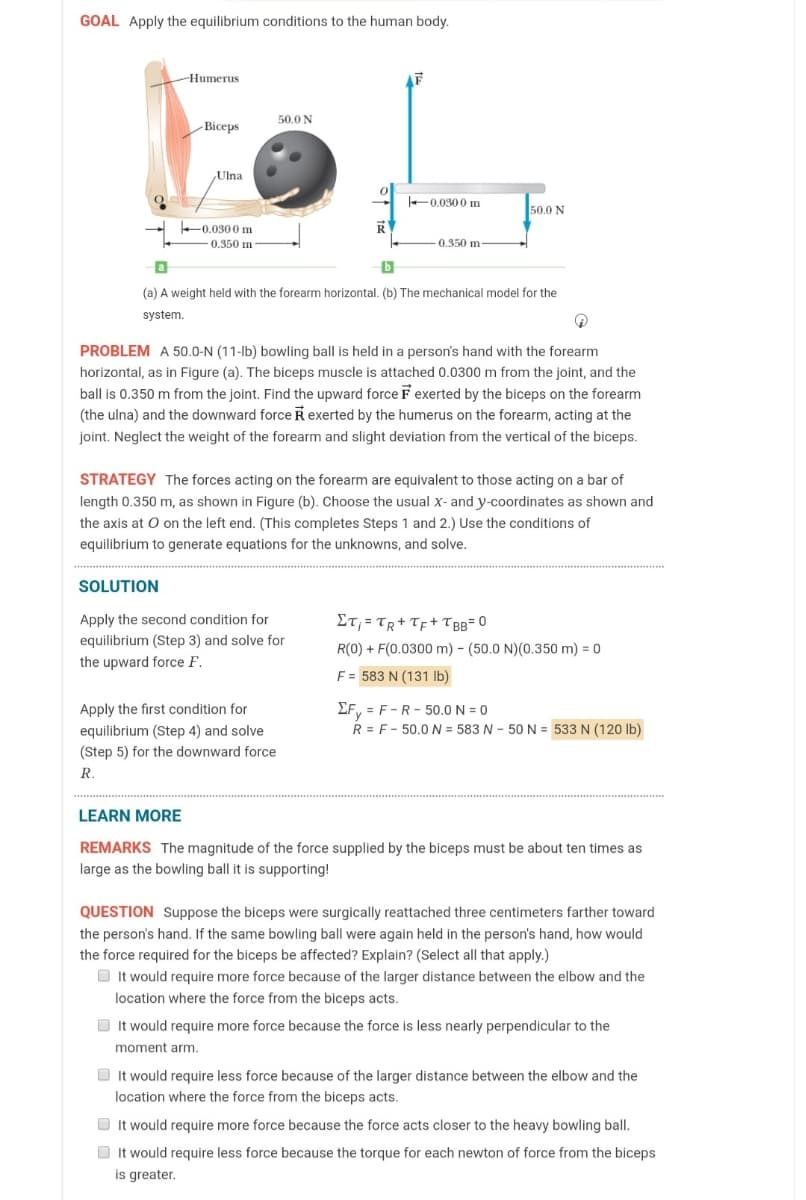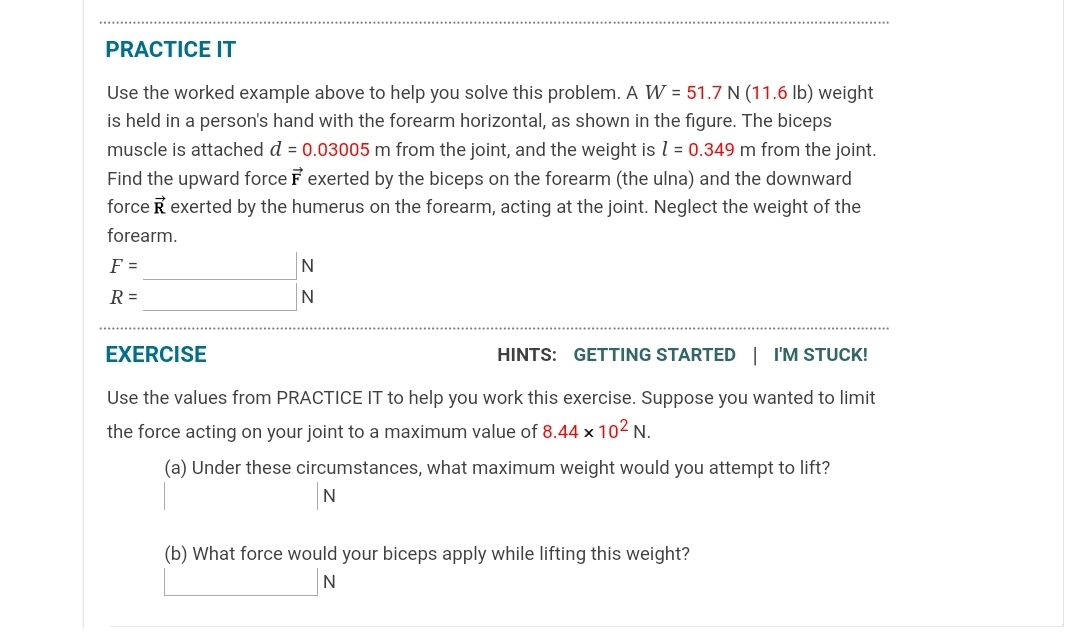Use the worked example above to help you solve this problem. A W = 51.7 N (11.6 Ib) weight is held in a person's hand with the forearm horizontal, as shown in the figure. The biceps muscle is attached d = 0.03005 m from the joint, and the weight is l = 0.349 m from the joint. Find the upward force F exerted by the biceps on the forearm (the ulna) and the downward force R exerted by the humerus on the forearm, acting at the joint. Neglect the weight of the forearm. F = R = N EXERCISE HINTS: GETTING STARTED | I'M STUCK! Use the values from PRACTICE IT to help you work this exercise. Suppose you wanted to limit the force acting on your joint to a maximum value of 8.44 x 102 N. (a) Under these circumstances, what maximum weight would you attempt to lift? (b) What force would your biceps apply while lifting this weight?
Use the worked example above to help you solve this problem. A W = 51.7 N (11.6 Ib) weight is held in a person's hand with the forearm horizontal, as shown in the figure. The biceps muscle is attached d = 0.03005 m from the joint, and the weight is l = 0.349 m from the joint. Find the upward force F exerted by the biceps on the forearm (the ulna) and the downward force R exerted by the humerus on the forearm, acting at the joint. Neglect the weight of the forearm. F = R = N EXERCISE HINTS: GETTING STARTED | I'M STUCK! Use the values from PRACTICE IT to help you work this exercise. Suppose you wanted to limit the force acting on your joint to a maximum value of 8.44 x 102 N. (a) Under these circumstances, what maximum weight would you attempt to lift? (b) What force would your biceps apply while lifting this weight?
College Physics
11th Edition
ISBN:9781305952300
Author:Raymond A. Serway, Chris Vuille
Publisher:Raymond A. Serway, Chris Vuille
Chapter8: Rotational Equilibrium And Dynamics
Section: Chapter Questions
Problem 91AP: The Iron Cross When a gymnast weighing 750 N executes the iron cross as in Figure lN.91a, the...
Related questions
Concept explainers
Rotational Equilibrium And Rotational Dynamics
In physics, the state of balance between the forces and the dynamics of motion is called the equilibrium state. The balance between various forces acting on a system in a rotational motion is called rotational equilibrium or rotational dynamics.
Equilibrium of Forces
The tension created on one body during push or pull is known as force.
Question

Transcribed Image Text:GOAL Apply the equilibrium conditions to the human body.
Humerus
50.0 N
- Biceps
Ulna
-0.0300 m
50.0 N
0.0300 m
0.350 m
0.350 m
(a) A weight held with the forearm horizontal. (b) The mechanical model for the
system
PROBLEM A 50.0-N (11-lb) bowling ball is held in a person's hand with the forearm
horizontal, as in Figure (a). The biceps muscle is attached 0.0300 m from the joint, and the
ball is 0.350 m from the joint. Find the upward force F exerted by the biceps on the forearm
(the ulna) and the downward force R exerted by the humerus on the forearm, acting at the
joint. Neglect the weight of the forearm and slight deviation from the vertical of the biceps.
STRATEGY The forces acting on the forearm are equivalent to those acting on a bar of
length 0.350 m, as shown in Figure (b). Choose the usual x- and y-coordinates as shown and
the axis at O on the left end. (This completes Steps 1 and 2.) Use the conditions of
equilibrium to generate equations for the unknowns, and solve.
SOLUTION
Apply the second condition for
equilibrium (Step 3) and solve for
the upward force F.
ET; = TR+ TF+ TBB= 0
R(0) + F(0.0300 m) - (50.0 N)(0.350 m) = 0
F = 583 N (131 Ib)
EF, = F-R - 50.0 N = 0
R = F- 50.0 = 583 N - 50 N = 533 N (120 Ib)
Apply the first condition for
equilibrium (Step 4) and solve
(Step 5) for the downward force
R.
LEARN MORE
REMARKS The magnitude of the force supplied by the biceps must be about ten times as
large as the bowling ball it is supporting!
QUESTION Suppose the biceps were surgically reattached three centimeters farther toward
the person's hand. If the same bowling ball were again held in the person's hand, how would
the force required for the biceps be affected? Explain? (Select all that apply.)
O It would require more force because of the larger distance between the elbow and the
location where the force from the biceps acts.
O It would require more force because the force is less nearly perpendicular to the
moment arm.
O It would require less force because of the larger distance between the elbow and the
location where the force from the biceps acts.
O It would require more force because the force acts closer to the heavy bowling ball.
O It would require less force because the torque for each newton of force from the biceps
is greater.

Transcribed Image Text:PRACTICE IT
Use the worked example above to help you solve this problem. A W = 51.7 N (11.6 Ib) weight
is held in a person's hand with the forearm horizontal, as shown in the figure. The biceps
muscle is attached d = 0.03005 m from the joint, and the weight is l = 0.349 m from the joint.
Find the upward force F exerted by the biceps on the forearm (the ulna) and the downward
force R exerted by the humerus on the forearm, acting at the joint. Neglect the weight of the
forearm.
F =
R =
EXERCISE
HINTS: GETTING STARTED | I'M STUCK!
Use the values from PRACTICE IT to help you work this exercise. Suppose you wanted to limit
the force acting on your joint to a maximum value of 8.44 x 102 N.
(a) Under these circumstances, what maximum weight would you attempt to lift?
N
(b) What force would your biceps apply while lifting this weight?
Expert Solution
This question has been solved!
Explore an expertly crafted, step-by-step solution for a thorough understanding of key concepts.
This is a popular solution!
Trending now
This is a popular solution!
Step by step
Solved in 2 steps with 1 images

Knowledge Booster
Learn more about
Need a deep-dive on the concept behind this application? Look no further. Learn more about this topic, physics and related others by exploring similar questions and additional content below.Recommended textbooks for you

College Physics
Physics
ISBN:
9781305952300
Author:
Raymond A. Serway, Chris Vuille
Publisher:
Cengage Learning

College Physics
Physics
ISBN:
9781938168000
Author:
Paul Peter Urone, Roger Hinrichs
Publisher:
OpenStax College

Physics for Scientists and Engineers: Foundations…
Physics
ISBN:
9781133939146
Author:
Katz, Debora M.
Publisher:
Cengage Learning

College Physics
Physics
ISBN:
9781305952300
Author:
Raymond A. Serway, Chris Vuille
Publisher:
Cengage Learning

College Physics
Physics
ISBN:
9781938168000
Author:
Paul Peter Urone, Roger Hinrichs
Publisher:
OpenStax College

Physics for Scientists and Engineers: Foundations…
Physics
ISBN:
9781133939146
Author:
Katz, Debora M.
Publisher:
Cengage Learning

College Physics
Physics
ISBN:
9781285737027
Author:
Raymond A. Serway, Chris Vuille
Publisher:
Cengage Learning